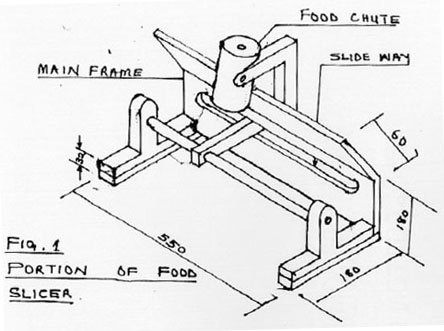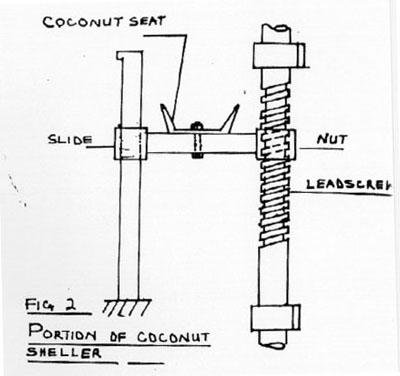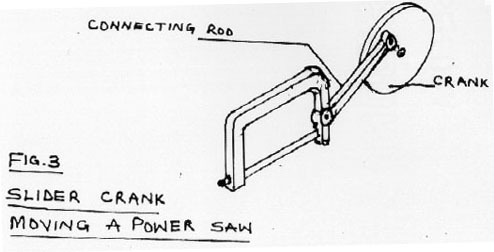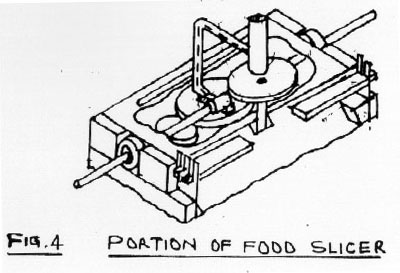 up
up
ENGINEERING DESIGN-COUPLING SCIENCE, TECHNOLOGY AND
ARTS
The background of the machine design student from the primary, secondary and early tertiary stages is traced. The interweaving of the machine design instruction with the periods of the students industrial work experience scheme (SIWES) in the second semesters of the 2nd, 3rd and 4th years enriches the applications-integral approach and sharpens the candidates perceptive aptitudes. In the Applications-Integral approach, the design of a centrifugal pump for example, is first studied as an art of pumping liquid and as a distinct engineering building block before the science of impellar design is taught to bridge the art with the technology. Engineering design would then be studied on the basis of a documentation of engineering building blocks (ebbs).
INTRODUCTION
In Nigeria up to the late 1970s science was studied as a combined subject in the early secondary school years but the combination was not for technical reasons but for convenience in curriculum development. Mathematics was then first studied in its traditional component parts, namely; arithmetic, geometry and algebra up to the final years of secondary school education. Today in early secondary school years science is studied as an integrated subject for technical reasons, under the following headings: Energy (for example, in batteries), Measurements (e.g. density in hydrometers), Machinery (e.g. inclined planes in screw threads) and Environment (vegetation, etc.). This approach to early science education aims to solve the later problem of low capacity to integrate scientific knowledge into functional technology at the tertiary and later levels. The present problem in developing countries is the inability to mobilize science into technology to solve the many problems facing these countries. In Nigeria, the effort to solve the problem is translated into the new education policy, code-named the "6-3-3-4 system" which took off since the 1980's. In the "6-3-3-4" system the normal candidate progressively spends six years in the reoriented primary school education, three years in the new "junior secondary" school, another three years in the senior "secondary school" and (if he is able) four years in the tertiary institution to obtain his first degree or diploma.
This education policy is interpreted into a curriculum that aims at making the candidate applications-oriented even from the primary school. The objective of practical orientation is maintained until the senior secondary school level when it seems to fizzle out because the candidate needs to obtain credit passes in the theoretical subjects (mathematics, physics, chemistry, biology, etc) in order to be admitted into a university. As the candidate enters the university he has considerably lost the practical applications orientation which he acquired in earlier secondary education. Therefore during the first year in the university the student admitted into the mechanical engineering department (which is the example in this study) offers one course each in workshop practice and engineering drawing together with mathematics, physics, chemistry, biology and humanities.
During the long vacation after the second semester (of the second year) the student participates in the students industrial work experience scheme (SIWES) for the first time. The industrial attachment is organized by the department with the cooperation of the industry which is selected on the basis of the relevance of its operations to the mechanical engineering profession [1].
After the industrial attachment (i.e. SIWES) the student submits his first main engineering report on the SIWES for the assessment of the department. The report at this stage invariably indicates that the students' understanding of machines and mechanisms is from the artistic point of view, unable to scientificate the imported technologies. The second SIWES is undertaken during the long vacation at the end of the third year and the students technical report on the industrial attachment indicates an improved understanding of the scientific basis of machinery and processes. However, his knowledge of the industrial technology from the artistic view point is considerably better at this stage than that from the scientific viewpoint, (over 80% of the technology is imported)! Even for industries using locally built machinery, the students understanding of the scientific basis for the machine designs follows a similar pattern.
In the first semester of the fourth year, the third and final basic course in machine design is offered. The course contents of the third machine design course include: belts, chains, cams, journal bearing, gears, etc. The whole period of the second semester (4 months) and the long vacation (over 2 months) of the fourth year is spent in industry participating in the SIWES. The technical report by the student on this final industrial attachment shows a clear balance between the students scientific, artistic and technological understanding of the machinery, industrial processes and management. In the final year (5th year) the student offers two more courses in design, namely: "Computer aided design and manufacture" and "Design of control systems". All the design and other core courses must be passed by the student before he can graduate from the University.
THE ROLE OF INDUSTRIAL WORKSHOPS IN THE APPLICATIONS-INTEGRAL APPROACH
The main engineering design laboratories used in teaching machine design in the application-integral approach are the workshops for maintenance of mechanical equipment like motor vehicles and machine tools. The motor vehicle with its high component variety offers very good example in the artistic and technological design of other machinery. Disused components of motor vehicles are gathered from the maintenance workshops by the students who also participate in maintenance in the workshops occasionally. The components related to the present design course are studied first from the arts point of view. For example, the simple automobile water pump is dismantled and its parts (especially the impellers) are sketched. The student uses this process to learn the art of pumping liquid which is also demonstrated later using a functioning automobile. If the instruction time permits, the water pump as an engineering building block (ebb), is fabricated using available materials and tested by the students. The basis for the selection of the dimensions of the pump parts especially the width, thickness and curvature of the impellers leads the student to the science of fluid impellers. Thus he acquires the art, science and technology of fluid pumping using centrifugal principles.
The study of engineering design at all the stages is projects-oriented and students-centered following the arts, science and technology coupling approach. With the dominance of imported machinery and processes in the industries in developing countries, the arts aspect of machine design becomes more important than the science if indigenous technology is to be developed at the present stage. Therefore the "scientification" of technology only follows the "artistication" of technology by way of "universal mechanisms" i.e "ebbs" documentation in developing countries because of the low capacity to harness existing science to develop technology in these countries. In the developed countries the favorable technological environment somewhat reduces dependence on documentation of engineering building blocks, (ebbs) in engineering design. However, this documentation will also simplify engineering design studies in developed countries.
Another example in the applications-integral approach is the design for rotational to linear translation motion. The automobile crankshaft is studied from the artistic aspects before being related to general slider-crank mechanisms. During this study, one final year project on "Food Slicing Machine" adopted the crank-shaft "art" (slider crank) to provide for the movement of the food chute (Figs. 1,3,4). The steering wheel and rack of the automobile's steering box and the screw and nut assembly of machine tools provided more compact "arts" for rotational-to-linear-translation solutions for another machine for slicing foods during the student projects.
Rotary to linear translation problems are encountered often in mechanical design projects. The application of existing engineering building blocks (ebbs) in the coupling of arts, technology, and science in machine design teaching is illustrated with the two main variants of rotary to linear motion in machinery, namely, the high speed and low speed problems. The coconut shelling machine project used the low pitch lead screw to illustrate the low speed solution while the (plantain) slicing machine adopted the slider crank mechanism to move the food chute for the high speed variant.
In the food slicer, the students are constrained to design to the specification that while a circular cutter rotates, the chute containing the food moves rapidly to and fro in a linear path (Figs.1 and 4). In the coconut sheller as the twin blades doing the shelling dig into the coconut pericarp, the coconut is fed gradually upwards to achieve the shelling. Using these specifications, 80% of the students were able to choose the appropriate mechanisms (artistically) namely: the slider crank, (fig.3) and leadscrew/nut (fig. 2) units from a general collection of ebbs mechanisms.
Having chosen the appropriate mechanisms from arts point of views, the sketches were produced followed by the calculation of dimensions from the magnitude of forces and motor power available.
Before the adoption of the Arts-Technology - Science coupling approach in teaching machine design in this department many earlier students had serious problems conceptualizing (creating) the machines on their own. The creative aspect of machine design is traditionally the most difficult and yet most important. The experience from the adoption of the ebbs coupling teaching approach shows that the problem of creativity in design solutions is considerably ameliorated, even if not entirely removed.
If creativity can ever be taught, the ebbs approach seems the most reliable proposition.
This department adopts the "OPEN" book approach in all its examinations on the machine design courses [2]. A catalogue of related ebbs (mechanisms) are made available to the students to enable them select the proper building blocks for their designs. Thus the arts (creative) aspect of the design can also be approached by the student under examination environment.
Indeed, machine design is a combination of arts, science and technology. The integration of the three components yields the complete design and so the subject is taught as such. This approach to teaching machine design sharpens the students perception and gives him confidence. In the department of mechanical engineering in this university, about 80% of the final year projects are in the machine design area by choice of the students themselves. This demonstrates the success and popularity of the Applications-Integral approach to teaching engineering design.
1. Achi P.B.U. "Approaching Tertiary Curriculum Design from Industrial Training Perspective." International Journal of Applied Engineering Education. Vol. 6, No. 4, 1988.
2. Department of Mechanical Engineering Harmattan Semester Examinations MEE 411: Machine Design III. Federal University of Technology, Owerri, 1990-96.
 up
up up
up up
up up
up